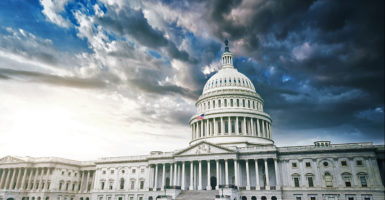Policymakers want to unleash economic growth in America by fixing our broken tax system. Or so they say.
Now that the conversation has moved beyond just lowering tax rates, pro-growth tax reform is in danger of losing the stuff that actually makes it pro-growth.
That’s because policymakers are caving to big-government advocates and other special interests. Here are the top five worst ideas that would surely dampen pro-growth tax reform.
1. Failing to enact full expensing.
Full expensing—allowing businesses to deduct the full cost of their investments when they incur those costs, instead of spreading them out over many years—is the best way to help businesses make investments that create jobs and raise wages for workers.
While the House Republican tax plan includes five years of full expensing, some policymakers want to reduce that to partial or temporary expensing. The problem with this is that it would leave all the damaging compliance costs of the current system in place.
Permanent full expensing would increase America’s economic output by over 5 percent. You cannot sacrifice more than 5 percent in additional growth and still call it “pro-growth” tax reform.
2. Not fully eliminating the deductions for state and local taxes and municipal bond interest.
These deductions mainly benefit high-income taxpayers and high-tax, high-debt state and local governments—to the tune of $1.7 trillion over 10 years.
By effectively forcing federal taxpayers to pay for a portion of a state and local government’s taxes and borrowing costs, these deductions encourage states to charge higher taxes and issue more debt than they should or otherwise would.
Not surprisingly, seven particularly high-tax states receive over 50 percent of the value of the state and local tax deduction: California, New York, New Jersey, Illinois, Massachusetts, Maryland, and Connecticut.
In addition to benefitting high-tax states, the state and local tax deduction benefits high-income taxpayers. This deduction is worth $6,300 for taxpayers who make over $200,000 a year, but it provides nothing to the 70 percent of taxpayers who don’t itemize their deductions.
Despite this unfairness, some policymakers want to “compromise” on the state and local tax deduction by incorporating property taxes into the mortgage interest deduction or by converting the deduction to a credit. But these changes would do next to nothing to reduce the harm caused by the current deductions.
Instead, policymakers should get rid of these deductions completely and use the revenues to reduce marginal tax rates—a move that we estimate could reduce marginal tax rates by as much as 16 percent. That’s what we call a pro-growth reduction.
3. Failing to reduce capital gains and dividends rates.
Countless economic studies show that capital gains and dividends taxes are detrimental, and are inferior at generating revenues compared with other forms of taxes.
When you double tax capital—first, taxing corporations on their profits, and then taxing individuals when they receive a portion of those profits as capital gains or dividends—you reduce the amount of capital in the economy. There’s also a strong and direct relationship between capital per worker and income per worker.
So far, we don’t know what the GOP tax plan would do to capital gains and dividend rates, but the current rates are unacceptable. At a top rate of 23.8 percent—and 43.4 percent for nonqualified dividends—the U.S. has some of the highest rates in the world, and they are dragging down economic growth.
Pro-growth tax reform must include lower rates on capital gains and dividends.
4. Focusing on “scores.”
Some policymakers are concerned with trying to maintain revenue neutrality, but a big part of generating economic growth comes transferring low- and no-value federal spending back to workers who will spend, save, and invest it more efficiently. As they do, the economy, incomes, and even federal tax revenues will grow.
Unfortunately, none of the official scores given to lawmakers adequately account for the positive economic effects of pro-growth tax reform.
5. Worrying about how much the “wealthy” will benefit.
The top 5 percent of taxpayers currently pay 60 percent of all federal income taxes, while the bottom 90 percent only pay 29 percent. It’s hard to enact pro-growth tax reform without creating some positive benefits for those who pay the majority of taxes.
Unfortunately, some policymakers are getting bogged down in estimates that show the wealthiest Americans would benefit significantly more than middle-income Americans. But that’s unavoidable.
If an estimated 45 percent of Americans don’t pay any federal income taxes, it’s hard to provide them with a bigger tax cut than those who face five-, six-, or even seven-figure tax bills.
Regardless of whether you think the wealthy should benefit from tax reform, the fact is that wealthy individuals and small businesses don’t just hoard money all to themselves. They put it back into the economy and ultimately into workers’ paychecks, creating more jobs and higher wages across all income groups.
By caving in to special interests and unreasonable political demands, policymakers could throw away the best chance they’ve had in decades to enact a truly pro-growth tax reform package.
A fully orbed tax proposal would provide much-needed tax relief to all Americans, make America a more competitive place to do business, and propel our lethargic economy out of its sluggish pace of growth.
Lawmakers need to push back on special interests and do what is best for our entire nation. A chance like this may not come around for another generation.


























